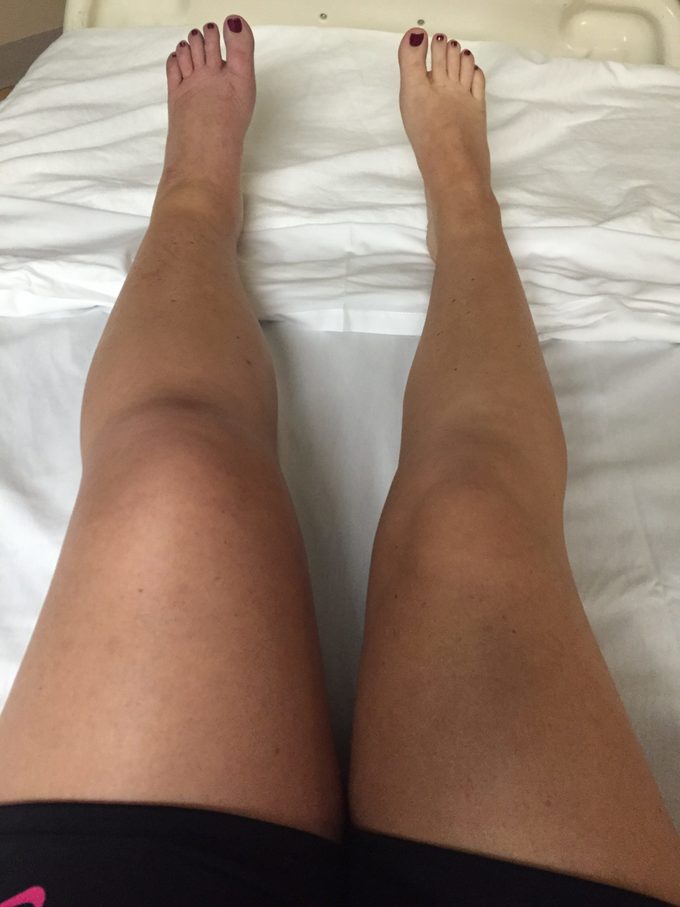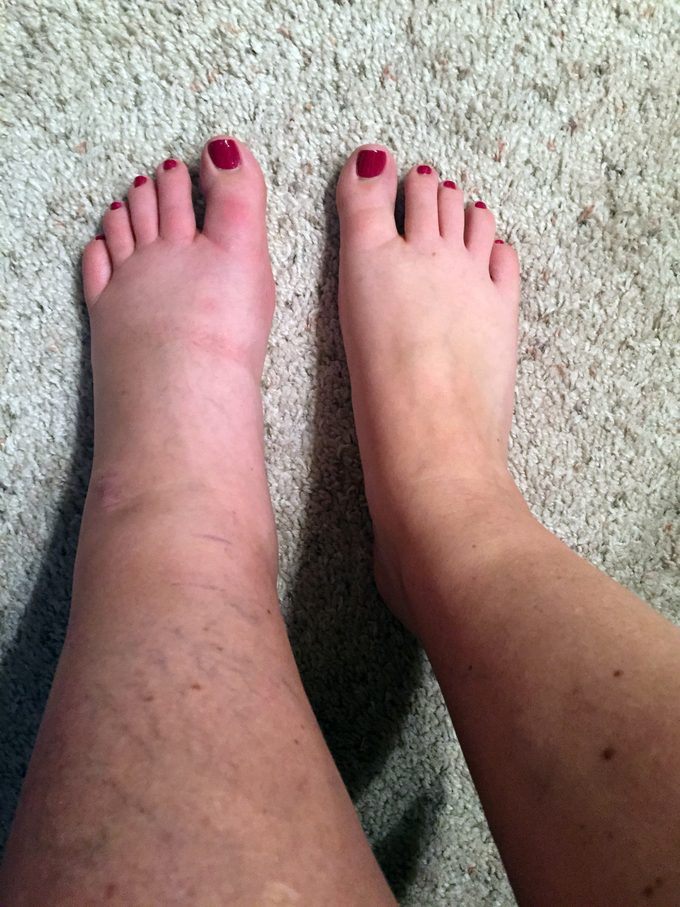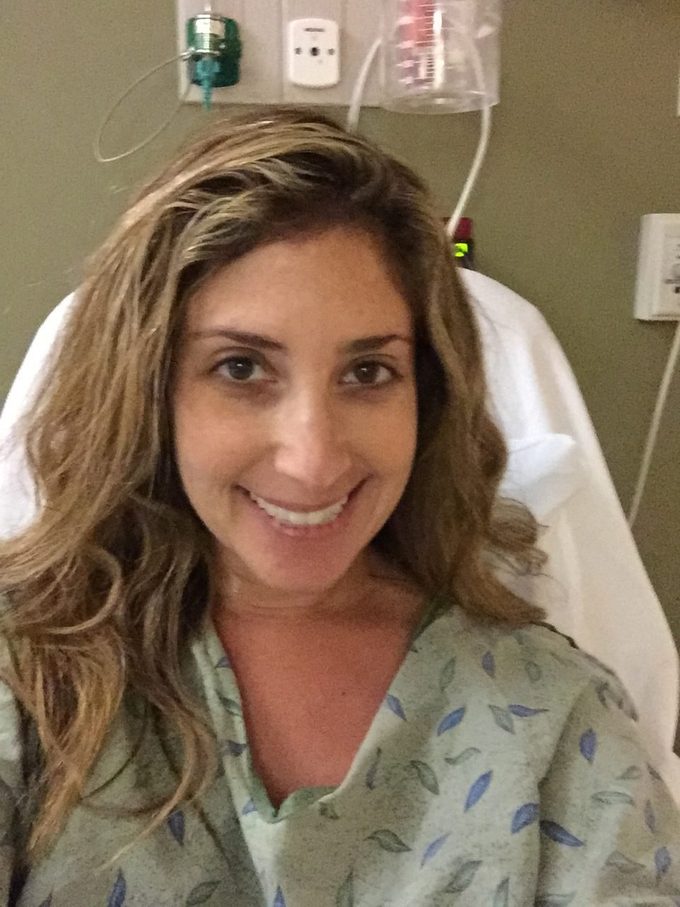I Almost Died of a Blood Clot at Age 38
An undiagnosed genetic mutation combined with birth control pills created the perfect storm for a limb-threatening deep vein thrombosis (DVT).

Monday
Three years ago while I was at work, I was hit suddenly by a blinding pain exploding in my groin. One minute I was on an afternoon conference call in my cubicle, and the next I shot up from my desk, hung up the phone mid-sentence, grabbed my purse, and hobbled out to my car. The pain was now shooting down my left leg. In fear and disbelief, I wondered how on earth I’d managed to injure myself while sitting at my desk.
Initially I went home, but then headed to the ER where I got a CT scan of my lower back (the staff assumed that was the source of my pain). When they couldn’t find anything, they pumped me full of morphine and recommended I get an MRI the next day. It was midnight at this point and I called a cab to take me home. Despite the morphine, I spent the rest of the evening suffering.
Tuesday
The next morning, I went to see my primary care physician. After a cursory exam, the staff made an appointment for me to have an MRI of my lower back. Morphine was making me nauseated so I had stopped taking it—therefore, I continued to suffer.
The MRI results suggested a bulging disc in my lower spine, which seemed strange, as I’d had no previous problems with my back. Feeling as though there was no solution in sight, I booked an appointment with a physical therapy center for the next day to see if there were any stretches that could help.
Doctors may also look in your eyes for clues to your health. Here are 5 conditions they can detect by looking in your eyes.

Wednesday
The next morning I realized my left leg was incredibly swollen, felt hot, and the skin had a purplish-red hue. I needed crutches to get around, but I made my way into the PT center. The therapist took one look at my leg and said: “You have a blood clot! You need to go to the hospital immediately!”
So I called my primary care physician again, and he told me to come right into the office. The next thing I knew, the ultrasound tech and my physician were barking orders at nurses and telling me to stay calm. It turned out that I had a massive deep vein thrombosis (DVT, or blood clot) and they were calling the hospital to book a room and admit me.
At the hospital, I was taken to a private room, where a doctor explained that a specialist would be by to assess me in the morning. I laid in the hospital bed all night, Googling my diagnosis and wondering why there wasn’t more of a sense of urgency surrounding my situation.
Thursday to Saturday
Around 9 a.m., hospital staff performed their own ultrasound on me. There was a noticeable shift in mood in the room, and suddenly more doctors and nurses were coming in. Somebody explained to me that the blood clot was enormous—stretching from my groin to my calf and that I’d be going into surgery immediately. I heard doctors murmuring the words “limb-threatening” and I really began panicking. Could I lose my leg over this? The answer was yes.
Thankfully, the procedure was successful. I had to spend the next three days in the ICU and underwent two more procedures: One to place a device to stop blood clots from travelling to my lungs; the second was an angioplasty to further open the vein.

Sunday
Finally, I was moved out of ICU and returned to a regular room. I was given a walker, surgical-grade compression socks to wear every waking moment of my life for the next two years—in an attempt to prevent pain, discomfort, and swelling. I was told to fill my prescription for blood thinners immediately. My head was spinning.
A week later
A week later, I met with a hematologist. He explained that my blood work revealed a blood clotting condition called Factor V Leiden—an inherited mutation of one of the clotting factors in the blood, which can increase the chance of developing abnormal blood clots, most commonly in the legs or lungs.
Women who carry the factor V Leiden mutation may develop blood clots during pregnancy. I’ve never had children, but taking the hormone estrogen also raises risk—and I had been on estrogen-containing birth control pills for nearly 20 years. I’d unknowingly created the perfect storm.
Between 3 and 8 percent of caucasians in the U.S. and Europe carry a copy of the factor V Leiden mutation. People who have inherited Factor V Leiden from only one parent have a 5 percent chance of developing an abnormal blood clot by age 65. (Hemophilia is a disorder which causes the opposite problem – the blood doesn’t clot.)
In my case, it was my mom who had unknowingly passed this gene down to me; to this day, thankfully, she has never had a complication.
The factor V Leiden mutation does not itself cause any symptoms—the first indication that you have the disorder may be the development of an abnormal blood clot. If you experience pain, swelling, redness or warmth, most commonly in your legs, you may have a DVT and should seek immediate medical attention.
Here are the other signs of a DVT blood clot.
Today
In the three years since my blood clot, I’ve had to find alternative birth control and deal with the reality that I will be on daily blood thinners for the rest of my life. My left leg no longer matches my right—it’s still swollen from my thigh down to my ankle (a result of permanent vascular damage) and slightly discoloured. But other than aesthetics and having to say goodbye to my entire shoe collection (my left foot is now half a size bigger and I can’t wrap any strappy styles around my cankle), I’m grateful that my leg is functional and still attached to my body.
Cari MacLean suffered a pulmonary embolism at age 50. Luckily, she beat the odds and survived. Read about her near-death experience next.




